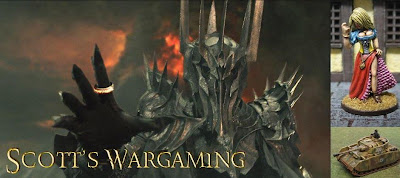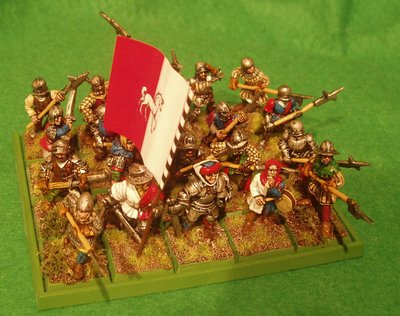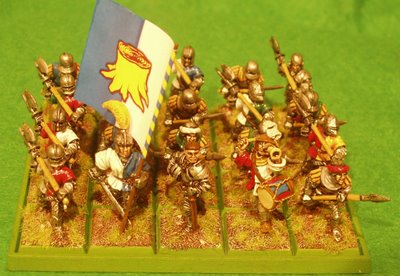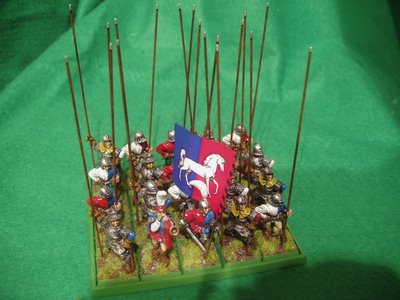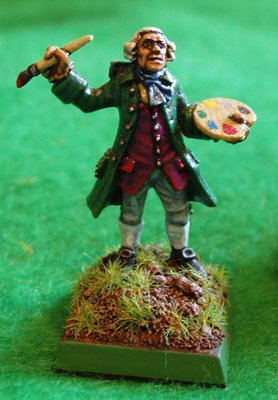 Painting miniature figures is an integral part of the wargaming hobby. Of course, how important it is to the individual wargamer varies from person to person. From one extreme you will have those who almost loath painting and are quite happy to use bare metal unpainted figures to enjoy their favourite game. To these players the game is more important than the figures themselves. At the other extreme, are those who are more collectors than wargamers and as such collect and paint figures to a high standard simply for their enjoyment of painting.
Painting miniature figures is an integral part of the wargaming hobby. Of course, how important it is to the individual wargamer varies from person to person. From one extreme you will have those who almost loath painting and are quite happy to use bare metal unpainted figures to enjoy their favourite game. To these players the game is more important than the figures themselves. At the other extreme, are those who are more collectors than wargamers and as such collect and paint figures to a high standard simply for their enjoyment of painting.Most wargamers probably fall somewhere between these two extremes.
For myself, I enjoy the game play greatly, but want to do it with well painted figures, and preferably on a games table covered in well made terrain scenic items, so the whole display is visually appealing. In other words, I want my cake and eat it too!
I started painting many years ago as a young teen-ager, and at that time, I was very happy to turn out, what I would now call basic paint jobs.
Having come from collecting and making Airfix model planes and tanks and painting them up with their enamel range of paints, I started using this approach for my figure painting. Initial attempts were poor and the smelly paints and thinners were unpleasant to work with.
After starting buying and reading White Dwarf magazine and the Citadel Journal of the time, I gradually learned the GW way of painting! This involved a switch to using GW's citadel range of water based acrylic paints. This brought instantly better results, but I still had a long way to go. I currently use a range of paints from GW's citadel range, and also Foundry's own paint range.
Learning about the need for a suitable undercoat, and then varnishing and making decorative bases, all were gradually incorporated into the final figure.
But still these early figures were mostly flat tones, with little or no shading or highlight, and basic detailing at best. But it was a worth while exercise as it taught a sense of discipline to make a tidy and complete paint job.
Having mastered this basic technique, I gradually advanced and learned about dry-brushing, and using shading ink washes, and how to add detail effects to eyes, and belt buckles and such like.
I still had a long ways to go, as I still found it a little difficult to get a small enough detail to the eyes, they often looked somewhat cartoon like if the eye went too large.
Also, the ink process was quite lengthy and messy, the ink often running onto adjacent areas, and required tidying up once dry. Also dry-brushing aswell could be a messy technique as again the paint would often hit other areas of the model you didn't want it to, again requiring more time spent tidying up the model, once dry.
More recently I have switched to the so-called "Dallimore" method, as used by Kevin Dallimore of Foundry.
The idea here is to start the model painting from the shade colour up. After undercoating (black) then paint on the darkest shade of paint first, and once this has dried, add the next lighter shade and so on. Several layers of paint can be done in this way depending on level of detail required of the model figure, and the patience of the painter. Ideally you would use three layers; shade, mid tone and highlight. However for speed and quickness, and for the majority of "rank and file figures" two layers seem sufficient - the shade and mid tone. I sometimes bother with the final highlight layer on character models or individual figures I am just painting for fun.
Oh, before I forget, painting the eyes, I used to find it easier to do after the black undercoat, but now I do after the shading wash.
Here's a pic of what i do, its a bit crude but you get the idea:
1. block paint base flesh colour
2. give a wash of brown colour, this will define nose and eyes
3. paint a white line across eye, this is usually the easy bit. If you make it too wide, let if dry and brush over with a slightly darker tone to base flesh tone you used (to match the base flesh tone plus wash)
4. Now do a vertical black line through the middle of the eye, starting by resting brush tip on middle of eye brow, and drag downwards. I find this far easier than trying to stab a black dot in the centre of the white line with a brush tip that will deform as you do so. It also helps your aim and focus and fines out the brush tip as you drag downwards.
5. Now reduce the excess black line carefully brushing over with a slightly darker tone to base flesh tone you used.
6. Add highlights to face to finish.
I will agree, this can be hard depending on posture of figure, and other things getting in the way; bushy beards and eyebrows, hats and helmets, especially helmets with face guards... but its still possible...
Another trick I have heard about though not tried is dotting in the pupil using a cocktail stick.
My painting style continues to evolve over time, as I try different things. One of the things with painting figures well, is it take time, and when you have large armies to assemble, it can be quite daunting, so finding short cuts are appealing. Recently a product has become available called 'Army Painter' from Warlord Games. I have been intrigued to try this product, but also put off by several negative comments on the web.
Consequently I have stuck with a technique that I know works, and switched to a new product. When GW relaunched the 'washes', I found these excellent products, give a shade wash without a gloss sheen as their old inks used to. But this little pots are expensive. However I found Vallejo do these, at least brown and black in large economical pots, and the product is juts as good as the GW one.
So now my painting technique has evolved to use this product and can be summarized thus:
Prep model; File and trim
Black Undercoat spray and paint touch up
Block paint in base colours
Wash whole model with a 50/50 mix of Vallejo dark brown and black wash.
Do eyes
Build up tones again by repainting original base colour as a first highlight.
Then add final highlight
Add any detailing effects as required.
Do base; PVA glue (thinned) and add sand, and paint and highlight as required, and finish with static grass and other decorative foliage materials as required.
I find using this brown shade wash over whole model, seems to blend whole model together, in a satisfactory manner.
I am not going to win any 'Golden Demon' awards, but I am not concerned about that. I just want good tabletop standard figures to build armies as quickly as practicable.
A couple of important points for novices - posture and lighting. The best posture I have found is elbows on the table and wrists locked together with model held at eye level.
Also, handling the figures can be made easier if you make some kind of prop to stick them to whilst painting. I have seen some folks use old empty paint pots. I made a bunch of 4" dowel rods with a 1" diameter circle of 5mm MDF wood on top (you can just see one in my hand as I paint the figure in picture below). I made an MDF wood base with holes drilled in to stand all these rods in.
And get a good angle-poise light and direct it down in front of you onto the model.
Musical accompaniment and a glass of your favourite tipple will not go a-miss. Earphones are optional!
Good luck!

